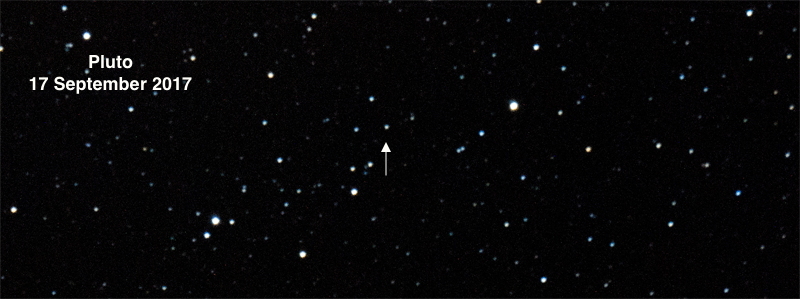Sun; Pluto, More Messier Globular Clusters
Posted: 19 September 2017
I opened the observatory during the day on Monday, 18 September 2017, for an attempt to capture a transit of the Sun by the Chinese Tiangong-2 space station, per the notice I received from CalSky.com.
|
Open: Monday, 18 September 2017, 1313 MST Temperature: 86°F |
Session: 1141 Conditions: Clear, windy |
Equipment Used:
12" f/8 LX600 w/StarLock
2" 24mm UWA eyepiece
Camera:
D7200 DSLR
I SYNCed the observatory clock to WWV. Then prepared the D7200 DSLR for prime focus imaging. I attached a full aperture solar filter to the 12" telescope.
1328 MST: LX600 ON, StarLock OFF, High Precision OFF.
Using the "Sun as Asteroid" technique, I did a GOTO the Sun. There was a small sunspot visible, 102X. However, seeing was not good at times.
I mounted the DSLR at prime focus and took this 1/1600sec, ISO 100, White Balance Auto, photo:

I was then ready for the transit to begin at 135050 MST. 1350 MST: began HD video recording, 1/60sec, ISO 100, WB Auto. I let the recording run for 1m13s. Unfortunately, due to the poor seeing and my error in overexposing the image (oops), I did not get the space station.
1354 MST: LX600 OFF.
|
Close: Monday, 18 September 2017, 1407 MST Temperature: 90°F |
Session Length: 0h 54m Conditions: Clear, windy |
|
Open: Monday, 18 September 2017, 1815 MST Temperature: 80°F |
Session: 1142 Conditions: Clear |
Equipment Used:
12" f/8 LX600 w/StarLock
2" 24mm UWA eyepiece
Camera:
D7200 DSLR
1828 MST: sunset.
Prepared the D7200 DSLR for this night's prime focus imaging. I then relaxed on the observatory patio bench while waiting for the sky to get darker.
1902 MST: LX600 ON, StarLock OFF, High Precision OFF.
1903 MST: viewed Saturn, 102X. Four moons visible.
1918 MST: watched an Iridium "flare", as predicted by SkySafari 5 Pro on my Apple Watch.
1925 MST: mounted the DSLR at prime focus of the 12" telescope. Began waiting for the end of Astronomical Twilight (1949 MST).
1944 MST: Wi-Fi ON. Used SkySafari 5 Pro on the iPhone to GOTO the planet Pluto. 1948 MST: StarLock ON for autoguiding.
1949 MST: imaged Pluto, 1 minute, ISO 6400, White Balance 3570K. By "blinking" this night's image with the previous image (taken about 23 hours earlier) I was able to identify Pluto:


Here is the "blinking" version:

1950 MST: Wi-Fi OFF.
I then began imaging more Messier globular star clusters for my Messier Catalog Astrophotography Album update. All images were StarLock autoguided, 30 seconds, ISO 3200, WB 3570K.
M55

M75

M71

M30

M15

At 2003 MST I moved the observatory dome OFF onto the PZT in order to image objects near the Zenith.
Imaging was a challenge this night as seeing was not very good. Autoguiding had some issues at times with the poor seeing and I had to retake many images to the get ones above.
2046 MST: StarLock OFF. Ended imaging. Viewed M15 (globular cluster), 102X.
2102 MST: dome ON.
2103 MST: LX600 OFF.
|
Close: Monday, 18 September 2017, 2111 MST Temperature: 71°F |
Session Length: 2h 47m Conditions: Clear |
Comments are welcome using Email. Twitter users can use the button below to tweet this report to their followers. Thanks.
Cassiopeia Observatory Home Page
Copyright ©2017 Michael L. Weasner / mweasner@me.com
URL = http://www.weasner.com/co/Reports/2017/09/19/index.html
